Norisoprenoids from the Brown Alga Sargassum naozhouense Tseng et Lu
Abstract
:1. Introduction
2. Results and Discussion
3. Materials and Methods
3.1. General
3.2. Plant Materials
3.3. Extraction and Isolation
3.4. Bioactivity Assay
3.4.1. PTP1B Inhibition Assay
3.4.2. DPPH Free Radical Scavenging Assay
3.4.3. Antimicrobial Activity
3.5. Statistical Analysis
4. Conclusions
Supplementary Materials
Acknowledgments
Author Contributions
Conflicts of Interest
References
- Huang, Z.G. Marine Species and Their Distributions in China’s Seas, 1st ed.; China Ocean Press: Beijing, China, 1994; pp. 216–221. ISBN 7-5027-3732-4. [Google Scholar]
- Peng, Y.; Gao, W.H.; Lin, X.P.; Yan, T.; Liu, Y.H. Chemical constituents of seaweed Sargassum naozhouense. J. Chin. Med. Mater. 2014, 37, 2210–2212. [Google Scholar] [CrossRef]
- Peng, Y.; Xie, E.; Zheng, K.; Fredimoses, M.; Yang, X.; Zhou, X.; Wang, Y.; Yang, B.; Lin, X.; Liu, J.; et al. Nutritional and chemical composition and antiviral activity of cultivated seaweed Sargassum naozhouense Tseng et Lu. Mar. Drugs 2013, 11, 20–32. [Google Scholar] [CrossRef] [PubMed]
- Xie, E.Y.; Liu, B.C.; Jia, C.; Chen, X.L.; Yang, B. Artificial seed production and cultivation of the edible brown alga Sargassum naozhouense Tseng et Lu. J. Appl. Phycol. 2013, 25, 513–522. [Google Scholar] [CrossRef]
- Lu, H.; Chen, X.; Ou, X.; Mao, J.; Ji, H. Anticoagulant activity of phlorotannins from S. naozhouense. Nat. Prod. Res. Dev. 2013, 25, 249–252. [Google Scholar] [CrossRef]
- Feng, M.; Li, Y.; Cui, L.; Liu, Y. The protective effect of phlorotannins from Sargassum naozhouense on bone loss in ovariectomized mice with hyperlipidemia. Chin. J. Osteoporos. 2015, 21, 586–591. [Google Scholar] [CrossRef]
- Sharifuddin, Y.; Chin, Y.X.; Lim, P.E.; Phang, S.M. Potential Bioactive compounds from seaweed for diabetes management. Mar. Drugs 2015, 13, 5447–5491. [Google Scholar] [CrossRef] [PubMed]
- Heo, S.J.; Park, E.J.; Lee, K.W.; Jeon, Y.J. Antioxidant activities of enzymatic extracts from brown seaweeds. Bioresour. Technol. 2005, 96, 1613–1623. [Google Scholar] [CrossRef] [PubMed]
- Shanmughapriya, S.; Manilal, A.; Sujith, S.; Selvin, J.; Seghal Kiran, G.; Natarajaseenivasan, K. Antimicrobial activity of seaweeds extracts against multiresistant pathogens. Ann. Microbiol. 2008, 58, 535–541. [Google Scholar] [CrossRef]
- Kimura, J.; Maki, N. New loliolide derivatives from the brown alga Undaria pinnatifida. J. Nat. Prod. 2002, 65, 57–58. [Google Scholar] [CrossRef] [PubMed]
- Chávez, J.P.; Santos, I.D.D.; Cruz, F.G.; David, J.M.; Yang, S.W.; Cordell, G.A. A quinoline alkaloid from Acanthosyris Paulo-alvinii. Phytochemistry 1997, 46, 967–968. [Google Scholar] [CrossRef]
- Park, K.E.; Kim, Y.A.; Jung, H.A.; Lee, H.J.; Ahn, J.W.; Lee, B.J.; Seo, Y.W. Three norisoprenoids from the brown alga Sargassum thunbergii. J. Korean Chem. Soc. 2004, 48, 394–398. [Google Scholar] [CrossRef]
- Liu, D.; Xu, M.J.; Wu, L.J.; Deng, Z.W.; Lin, W.H. Norisoprenoids from the marine sponge Spheciospongia sp. J. Asian Nat. Prod. Res. 2009, 11, 811–816. [Google Scholar] [CrossRef] [PubMed]
- Nakayama, M.; Fukuoka, Y.; Nozaki, H.; Matsuo, A.; Hayashi, S. Structure of (+)-kjellmanianone, a highly oxygenated cyclopentenone from the marin alga, Sargassum kjellmanianum. Chem. Lett. 1980, 9, 1243–1246. [Google Scholar] [CrossRef]
- Zhang, W.; Hong, D.; Zhou, Y.Y.; Zhang, Y.N.; Shen, Q.; Li, J.Y.; Hu, L.H.; Li, J. Ursolic acid and its derivative inhibit protein tyrosine phosphatase 1B, enhancing insulin receptor phosphorylation and stimulation glucose uptake. Biochim. Biophys. Acta 2006, 1970, 1505–1512. [Google Scholar] [CrossRef] [PubMed]
- Sharma, O.P.; Bhat, T.K. DPPH antioxidant assay revisited. Food Chem. 2009, 113, 1202–1205. [Google Scholar] [CrossRef]
- Santhosh, S.K.; Venugopal, A.; Radhakrishnan, M.C. Study on the phytochemical, antibacterial and antioxidant activities of Simarouba glauca. Indian J. Biol. Sci. 2016, 2, 119–124. [Google Scholar] [CrossRef]
Sample Availability: Sample of the compound 6 is available from the authors. |
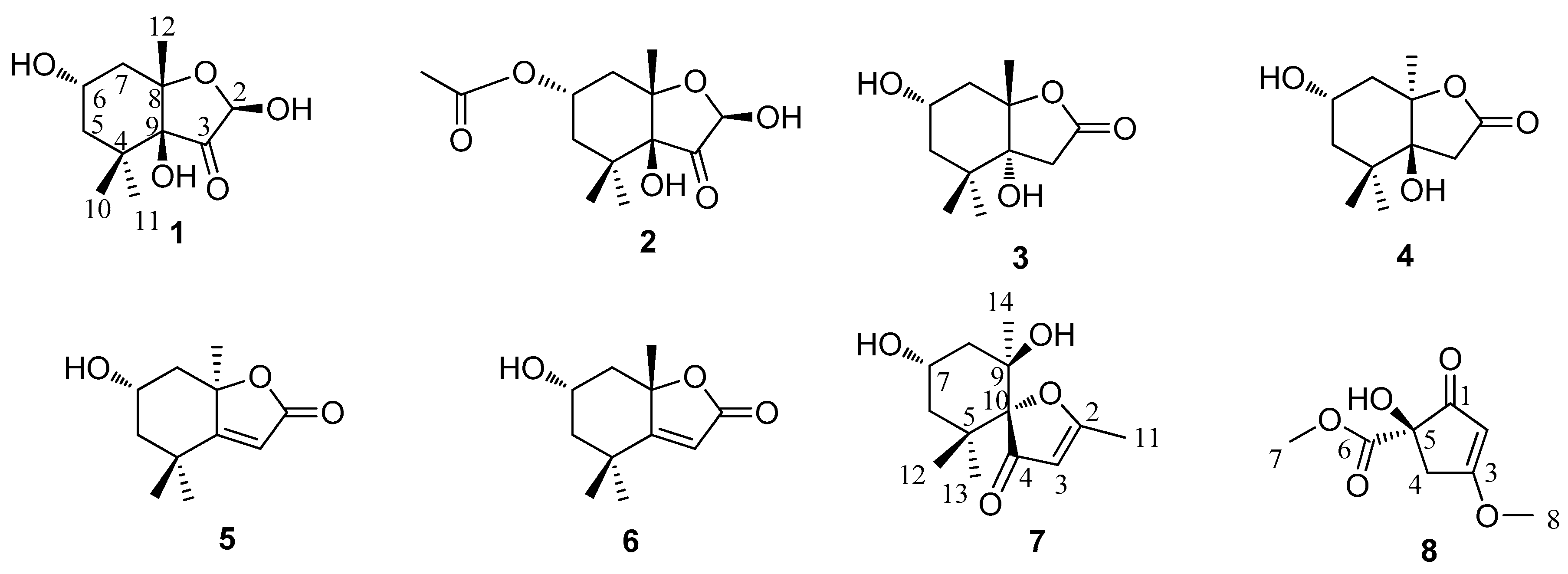
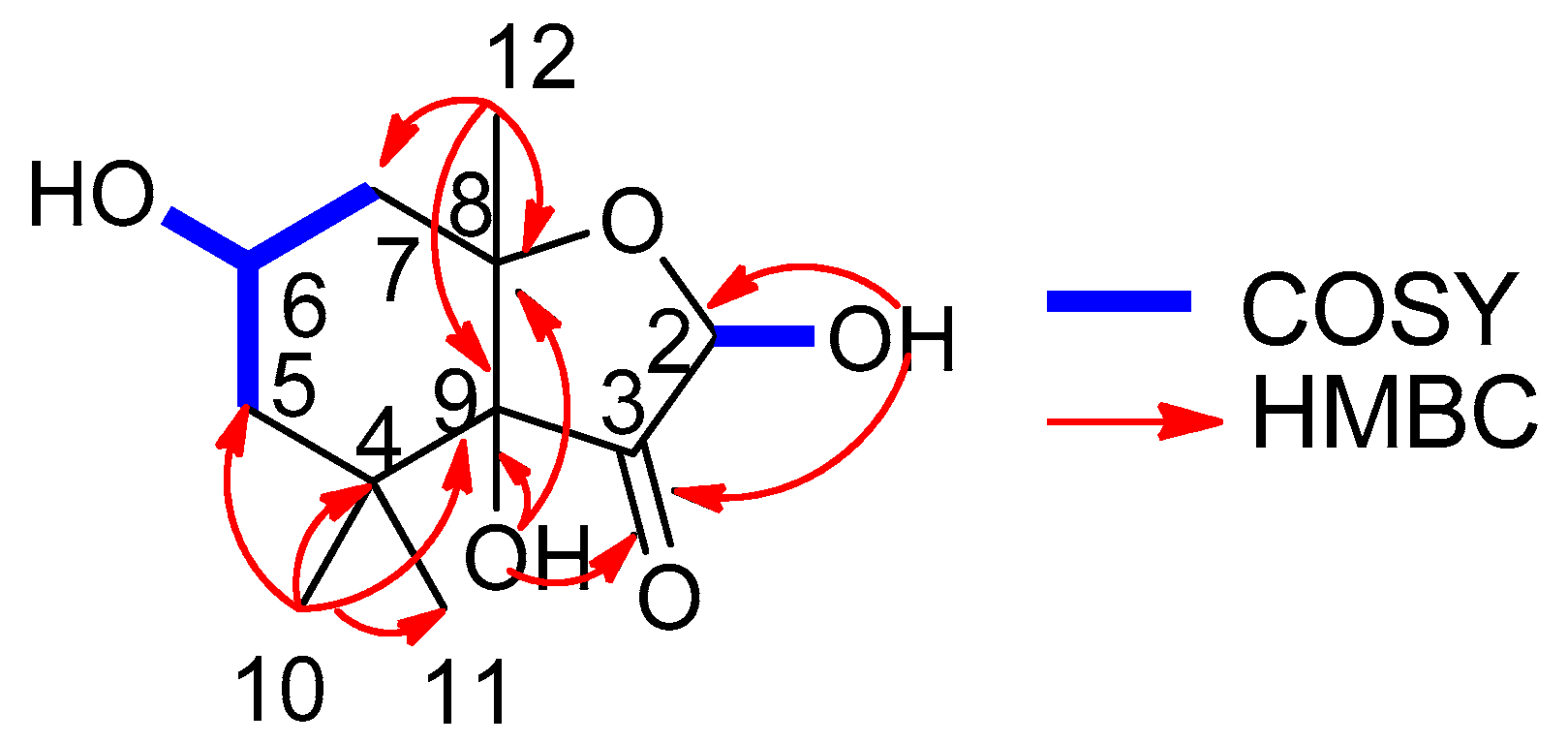
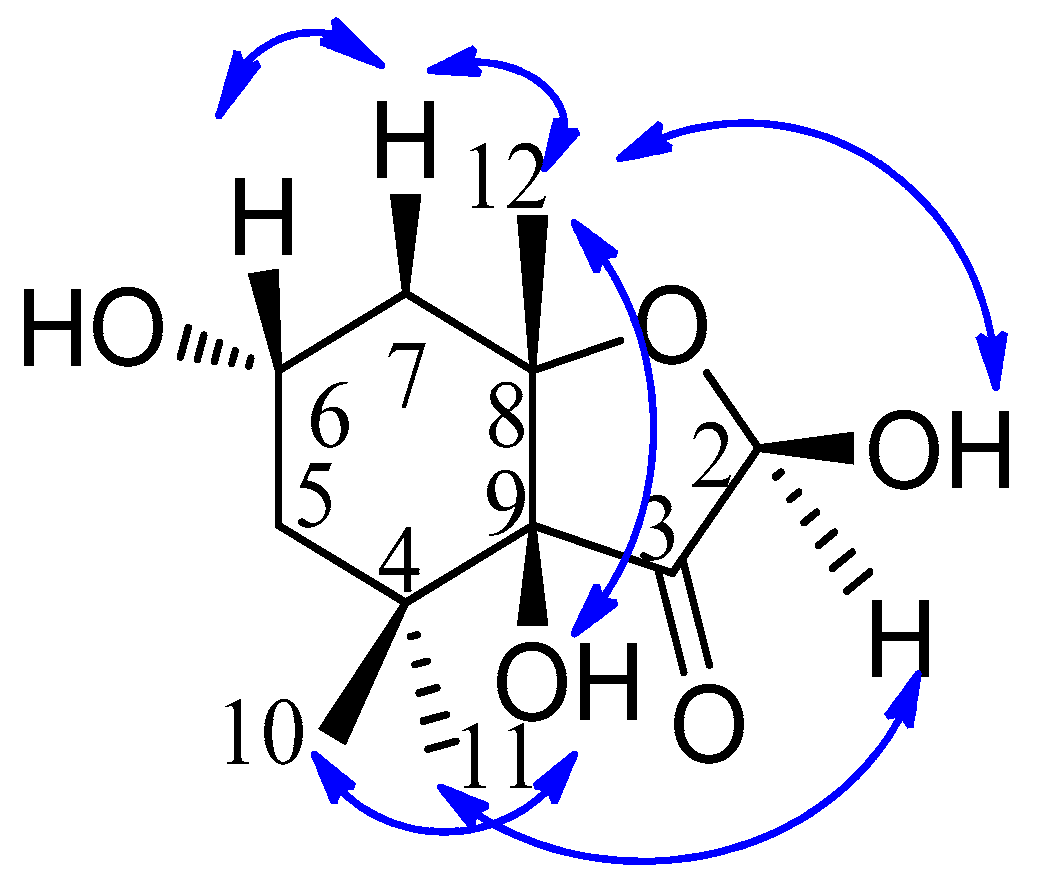
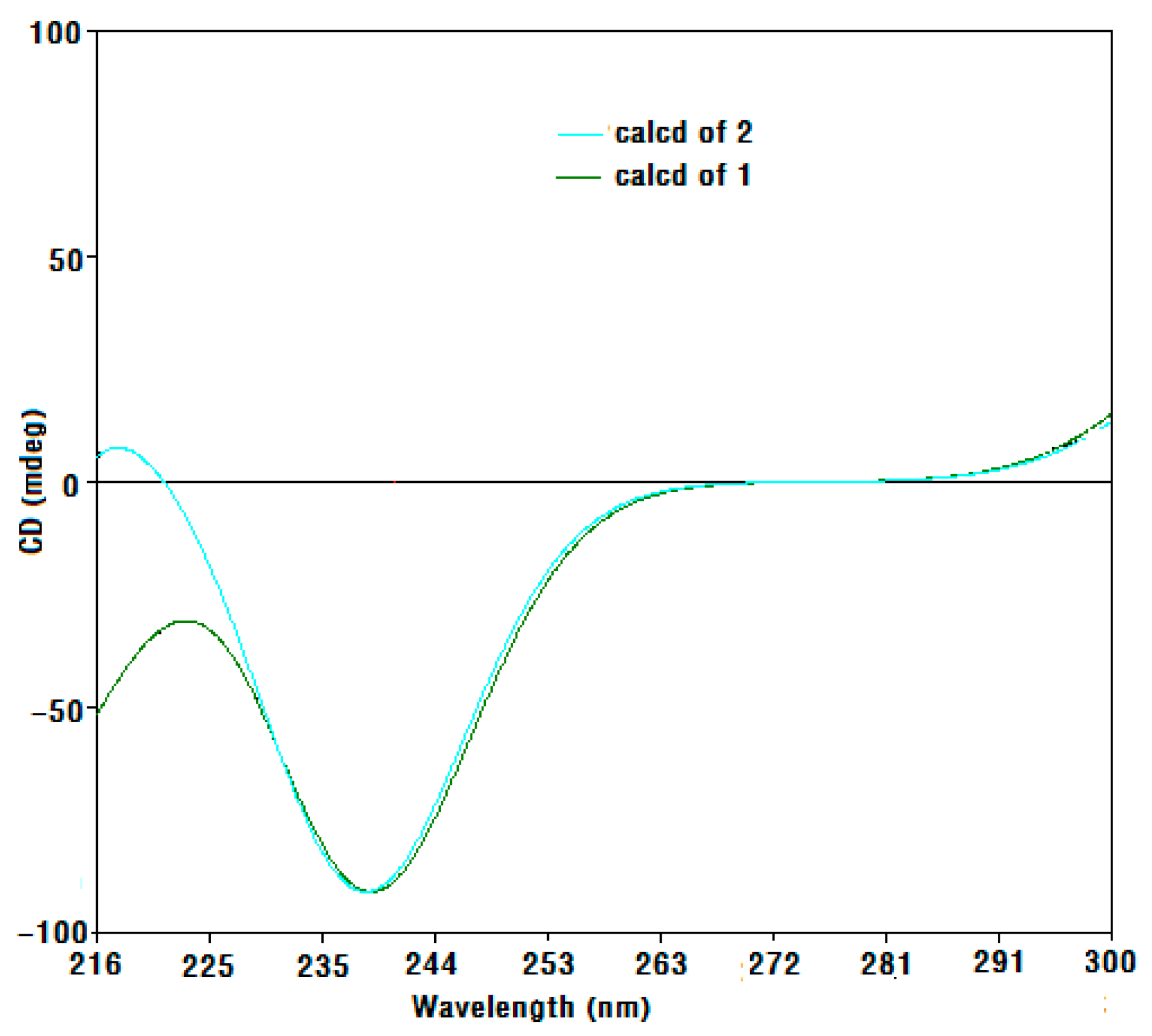
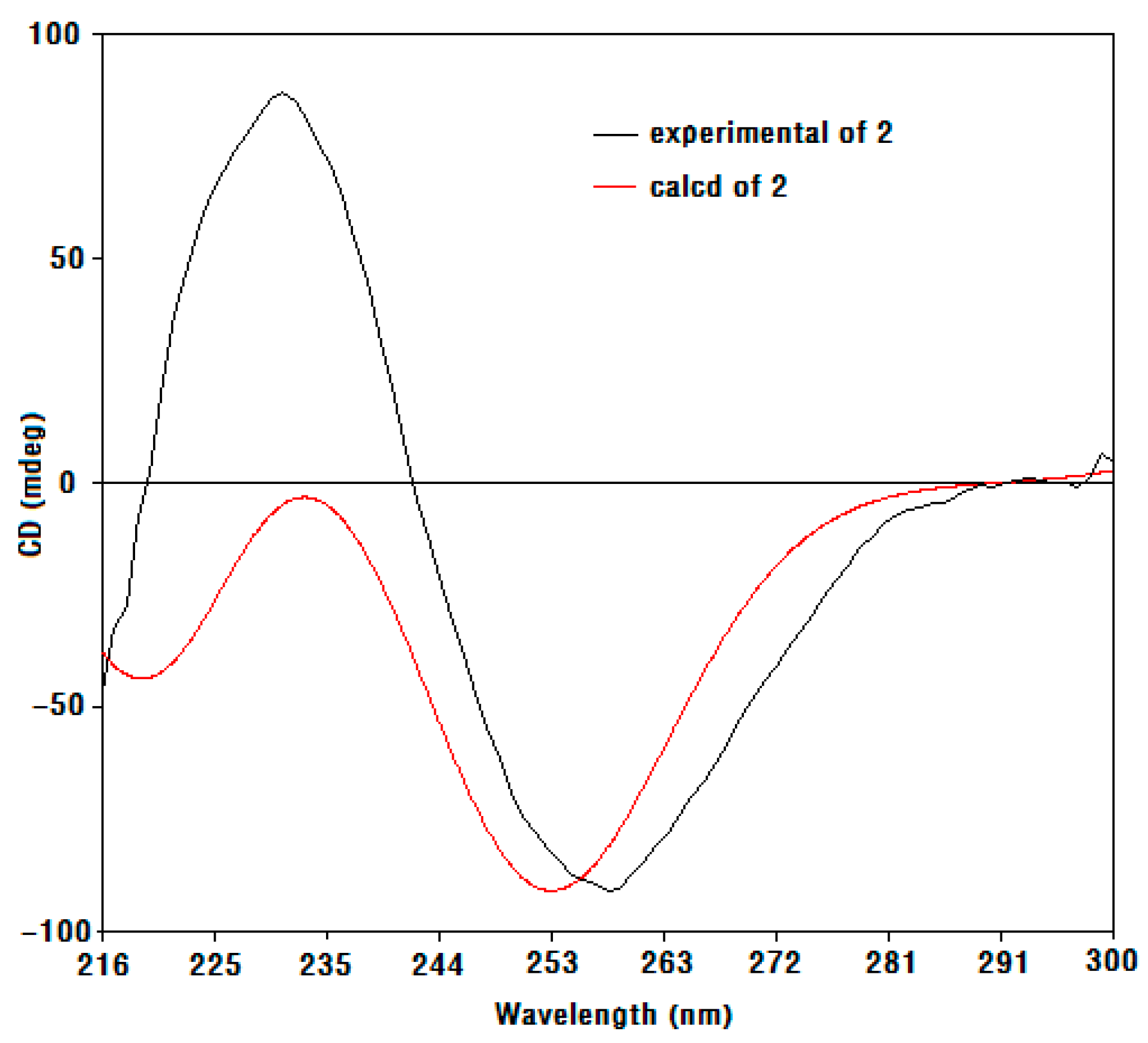
| Position | δC | δH | HMBC (HC) |
|---|---|---|---|
| 2 | 92.6 | 4.93 d (6.0) | 84.6 |
| 3 | 214.8 | ||
| 4 | 37.1 | ||
| 5 | 44.4 | 1.36 m | |
| 6 | 61.6 | 3.79 m | |
| 7 | 43.1 | 2.07 dd (4.5, 4.5) | 44.4, 61.6, 80.6, 84.6 |
| 8 | 84.6 | ||
| 9 | 80.6 | ||
| 10 | 26.1 | 0.86 s | 25.7, 37.1, 44.4, 80.6 |
| 11 | 25.7 | 0.95 s | 26.1, 37.1, 44.4, 80.6 |
| 12 | 27.6 | 1.14 s | 43.1, 80.6, 84.6 |
| 2-OH | 7.03 d (6.0) | 92.6, 214.8 | |
| 6-OH | 4.55 d (4.5) | 44.4 | |
| 9-OH | 5.36 s | 37.1, 80.6, 84.6, 214.8 |
| Compounds | Inhibitory Activity (IC50, μmol/L) # |
|---|---|
| 6 | >50 |
| Oleanolic acid | 1.9 ± 0.3 |
| Compounds | IC50 (mM) |
|---|---|
| 6 | 17 ± 0.35 |
| Vitamin C | 0.11 ± 0.01 |
| Strains | Zone of Inhibition (mm) # | ||
|---|---|---|---|
| 6 | Tetracycline | Penicillin | |
| Candida albicans 615 | 6.50 ± 0.20 | 10.50 ± 0.23 | – |
| MRSA 315 | 8.20 ± 0.11 | 11.00 ± 0.10 | – |
| Escherichia coli 234 | 7.00 ± 0.20 | 12.00 ± 0.06 | – |
| Staphyloccocus aureus 29213 | 7.50 ± 0.40 | 9.50 ± 0.52 | 11.00 ± 0.05 |
© 2018 by the authors. Licensee MDPI, Basel, Switzerland. This article is an open access article distributed under the terms and conditions of the Creative Commons Attribution (CC BY) license (http://creativecommons.org/licenses/by/4.0/).
Share and Cite
Peng, Y.; Huang, R.-M.; Lin, X.-P.; Liu, Y.-H. Norisoprenoids from the Brown Alga Sargassum naozhouense Tseng et Lu. Molecules 2018, 23, 348. https://doi.org/10.3390/molecules23020348
Peng Y, Huang R-M, Lin X-P, Liu Y-H. Norisoprenoids from the Brown Alga Sargassum naozhouense Tseng et Lu. Molecules. 2018; 23(2):348. https://doi.org/10.3390/molecules23020348
Chicago/Turabian StylePeng, Yan, Ri-Ming Huang, Xiu-Ping Lin, and Yong-Hong Liu. 2018. "Norisoprenoids from the Brown Alga Sargassum naozhouense Tseng et Lu" Molecules 23, no. 2: 348. https://doi.org/10.3390/molecules23020348





